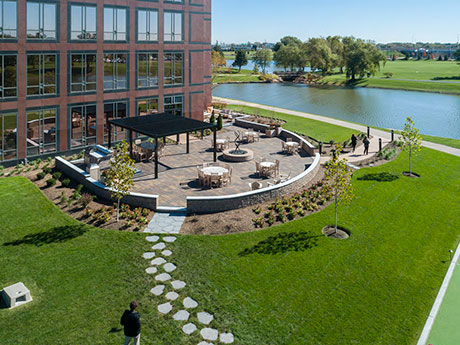By Mark Kolar, Cresa
There’s been a lot of news recently about the financial pressures facing suburban Chicago commercial office landlords who have financed their office buildings via commercial mortgage-backed securities (CMBS) loans. While the financial challenges these buildings face continue to grab the headlines, there is a much less visible yet greater amount of privately funded commercial office landlords that could be facing dire financial changes over the next couple of years.
These privately funded loans that originated through major banks and insurance companies are seeing just as much, if not more, stress than their CMBS counterparts. Collectively we’re seeing significant systemic issues for all Chicago commercial office landlords with no clear path to a solution in sight.

In suburban Chicago, about 13 percent of commercial office loans are financed by CMBS loans with the majority of loan debt financed through local financial institutions, private investment funds and insurance companies. While details on these loans is not as readily available as their CMBS counterparts, many office landlords are confronting similar challenges.
Both CMBS and privately funded commercial landlords and their lenders are facing a host of capital challenges that revolve around systemic changes in leasing activity, increasing costs of capital and a system-wide slowdown in lending activity.
Over the past 10 years, suburban Chicago commercial office vacancy rates have climbed from 18 percent to an historic high of 28 percent, with a significant portion of this increase occurring over the past three years. The increase in vacancy is related to a host of factors, including a slowdown in “homegrown” businesses in Illinois as well as a reevaluation of the function of office space moving forward.
Commercial office markets in this area have never faced the kind of uncertainty that we’re facing today. The bad news for suburban Chicago landlords is that current vacancy rates are expected to increase as more and more companies look into more efficient ways to utilize their real estate.
We are just starting to see the effect of current market conditions on building owners, but things can get a lot worse. A building owner who purchased its building in the last five to 10 years is likely to have had their rental income cut by 6 to 8 percent due to increased vacancy — with additional declines in rental income yet to come.
While vacancy rates have increased over the past 10 years, average market pricing for commercial office buildings has steadily climbed from $140 to $155 per square foot. Essentially over the past 10 years, landlords have been paying a significantly higher price for buildings with lower value.
As building owners look for any signs of hope in their future, market fundamentals don’t seem to be working in their favor. Leasing activity has been on the decline for the past several years, and there are no signs of a rebound any time soon.
In looking for a way forward for the suburban Chicago office markets, we might need to make hard decisions relating to what we want to do with excess building inventory. Some questions to ask are: Will suburban Chicago need 100 million square feet of office inventory moving forward? Is there a way to repurpose existing inventory? What can we do to increase demand through business growth? Do we need to start considering redevelopment/repositioning options for the bottom 10 percent of buildings that conduct business with perpetually low occupancy rates? Also, where do the building lenders and their ownership groups fit into this equation?
We have recently seen several significant office buildings trade at auction at pennies on the dollar. These include several well-located buildings that could be considered Class A/B by most standards.
As we consider the winners and losers in the market, we are seeing a continued flight to quality. Companies that are requiring their employees to be back in the office are also looking for a higher level of hospitality-oriented amenities and better infrastructure. “Commute worthy” is a term that is floating around commercial real estate circles as companies and their landlords try to zero in on the right blend of employee experiences needed to draw employees back and make their buildings thrive again.
Landlords that have found the “right mix” have seen better control of their rent pricing while also driving occupancy. The losers in this market tend to be older vintage buildings that lack the capital investment and are not as welcoming. These buildings might also be in inferior locations that are isolated from public transit and other lifestyle (live/work/play) amenities.
It cannot be overstated — we are in uncharted territory. It will take patience and creative problem solving to remedy the market. And when we do return to some sort of normalcy it’s probably going to look a little different than before. Only time will tell.
Mark Kolar is a senior vice president with Cresa. This article originally appeared in the March 2023 issue of Heartland Real Estate Business magazine.


